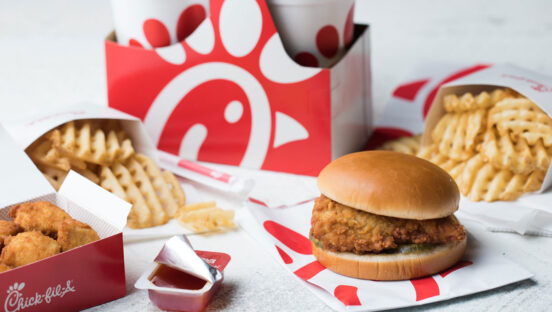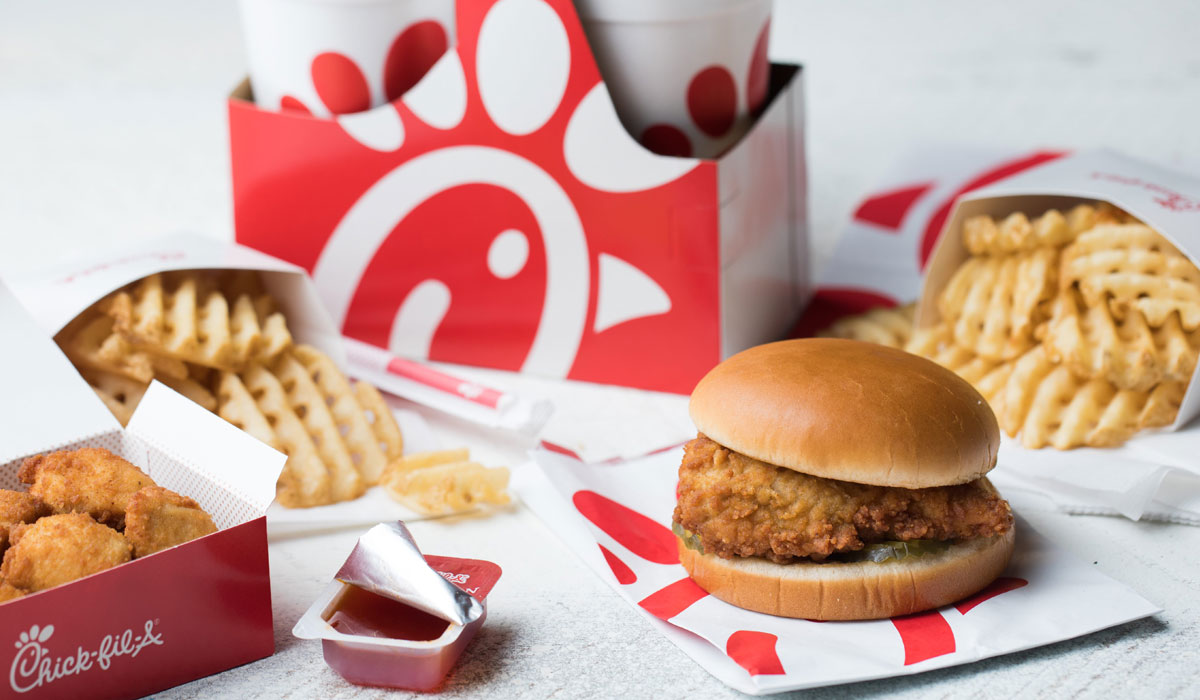Chick-fil-A generated $18.814 billion in U.S. sales across 2022, a figure that trailed only McDonald’s ($48.7 billion) and Starbucks ($28.1 billion) and illustrated what’s been one of the industry’s fastest climbs. In 2019, the chain earned $12.2 billion and bumped to $13.7 billion and $16.67 billion in the ensuing years. Total revenue and income climbed from $4.32 billion to $6.37 billion. Average-unit volumes at freestanding drive-thrus ended 2022 at $8.676 million, up from $8.142 million and $7.096 million in 2021 and 2020, respectively.
So how does that calculate in less mathematical terms? Chick-fil-A on Tuesday shared a review of 2022 and some insights into how it got there. Among the headlines: The brand served 2.1 billion guests last year and some 527 million chicken sandwiches.
Chick-fil-A also opened 138 locations, selected 100 new operators, and entered two fresh markets—Puerto Rico and Hawaii.
In the report, the company unpacked a handful of initiatives, from ESG to community to labor. Focusing on the latter, Chick-fil-A supported 835 operators, employees, and front-line staff through its Together Fund. That amounted to $411,000. Since its October 2021 launch, roughly 1,700 staff members have received north of $760,000 in assistance grants. The brand handed out more than $24 million in Remarkable Futures Scholarships to 12,700 employees and clocked 7,000 hours of staff volunteeersim and community service across 1,825 employees. Full-time staff receive 40 “Wellness Hours” each year to engage in opportunities.
Chick-fil-A has a 2025 goal of impacting over 50,000 workers through education opportunities (it’s 53 percent of the way there at 26,892).
Also, Chick-fil-A shared some operator wins, including Miami, Florida, store leader Justin Lindsey’s introduction of a three-day work week. More on that here. Lindsey, in an effort to reduce burnout and improve retention, created two pods of employees who condense week-long schedules into three-day blocks of 13- to 14-hour shifts. The program began in February 2022 and, as of the fall, was appreciating 100 percent retention at the management level. In one job posting, the store collected more than 420 applicants.
Lindsey told QSR the model resonated because it provided stability in a historically volatile setup. Employees get a set schedule and can plan their lives outside of work, including knowing they’re getting off a seven-day stretch each month.
Operationally, the continuity of longer shifts with the same group established consistency through familiarity and stability. Not to mention, the store was on pace for $17 million in sales.
There’s an operator in Tulsa, Oklahoma—David Chen—who created a “Climb Mentorship” program five years ago where employees can grow their careers with his business. Participants work on six lessons over three months with senior leaders to understand goal setting, identify and leverage their strengths, and develop other aspects of leadership. Since its onset, more than 90 workers have graduated and roughly 60 percent advanced to leadership roles within Chen’s restaurant.
Jon Goolsby, who runs a Houston, Texas, Chick-fil-A, gave a Thanksgiving turkey or pecan pie to each of his 180 employees. Jefferson City, Missouri, operator Kylie Oberweather, offered her skills as a trained therapist to front-line workers.
In St. Georges Avenue and Linden, New Jersey, Marlon Terrell posted a QR reader on the wall for employees to scan and express interest in advancement. Then, personalized career and development conversations were scheduled within 48–72 hours. Two of Terrell’s employees got accepted as Chick-fil-A operators and one joined the company’s corporate training and development program. “Our transparent and equitable growth strategy is an investment in people, which creates opportunity and reduces turnover,” Terrell said. “This commitment fuels the growth of our business and, ultimately, empowers us to have a greater impact on our community.”
Brooklyn, New York, operator Brandon Hurst acquired a multi-family housing unit near his location to offer affordable housing to employees, and also teaches entrepreneurship and business skills to those interested.
Chick-fil-A last year also opened three “mini restaurants”—in Baltimore, Maryland; Grand Rapids, Michigan; and Tulsa, Oklahoma, to help teach young people across a variety of skills.
Chick-fil-A continued to invest in DE&I as well. It created a Steering Committee with representatives from corners of its business to provide insight and feedback. Additionally, Chick-fil-A offers a DE&I Operator Advisory Panel that gathers 21 operators to regularly debate topics.
The brand created “Learning Circles” to provide opportunities for small groups to connect and share their thoughts and concerns. There are internal programs like an “Around our Table” video series where employees tell their stories and Chick-fil-A experiences. “Not only are we called to prioritize DE&I by our corporate purpose, but as Chick-fil-A grows and moves into the future, we have the opportunity to help build bridges that connect people,” said Erick McReynolds, VP of diversity, equity, and inclusion at Chick-fil-A.
Benefits remain a moving target, with an aim toward health and wellness. Chick-fil-A staff in Atlanta, for example, have access to in-network advanced primary care health services at two near-site clinics. There’s also on-site childcare services and reimbursement for support center workers for alternate childcare, and free summer gym access for high school students, as well as suicide prevention training and access to educational content.
Broadly, given Chick-fil-A’s 97 percent franchised model, each store offers a different slate of compensation and benefits. But many present perks from health coverage to 401(k), and meal discounts, the company said.
Another area Chick-fil-A spotlighted in the report was its movement around the gig economy. It created a “Gigs and Opportunity Marketplace” where employees can take on short-term jobs across the company. It said this helps “staff expand their talents, gain a greater understanding of the business, meet evolving business needs, and build meaningful relationships with other employees.” Additionally, each employee has an annual development budget to put toward career goals. Chick-fil-A then hosts a number of learning opportunities throughout the year, from Leadership Strategies, Critical Conversations, and Persuasive Presentations that help workers develop career ladders. “We continue to cultivate work full of opportunity,” Libby Wanamaker, VP of talent experience, said. “The Gigs and Opportunity Marketplace is just one way staff are encouraged to invest in themselves and take advantage of a multitude of available career development resources and opportunities.”
[image source_ID=”134992″]
Chick-fil-A has two support centers—Atlanta and Irvine, California. They’ve been designed as flexible campuses. There are open areas, private nooks, conference rooms, etc. The Atlanta spot is one of 578 certified arboreta worldwide, which includes walking trails, a rooftop garden, and WiFi-enabled outdoor spaces.
There’s now a “Flexible Futures” function that covers Chick-fil-A’s hybrid in-person and remote work policy. “Our job is to create environments and experiences that people find enriching,” said Christina Coleman, senior director of campus planning and operations. “One of the ways we do this is by investing in workspaces where people want to be and where they feel valued.”
“Being a restaurant company, we also believe that people spending time together over food is important,” Coleman continues. “We provide complimentary meals to all staff at our support center locations in a wide variety of spaces to encourage this connection. Having an open design that fosters relationships brings our Chick-fil-A values to life.”
These support centers engage in sustainability efforts as well, including compositing, recycling, and EV charging stations. Signage uses environmentally friendly materials like cardboard, wood, and post-consumer recycled composites.
In a similar vein, Chick-fil-A said it’s the first U.S. quick-serve to pilot a solar-powered microgrid system for its store locations. While microgrid systems are typically used in larger facilities, the company said, Chick-fil-A is testing a system specifically designed for a 5,000-square-foot building. At one in California, solar panels collect sunlight that is converted into renewable energy to power the restaurant and an on-site battery provides continuous power during local outages. It also save money in places where energy costs spike in the summer. “That’s money I’d rather reinvest in our team and our community,” said April Farage, operator of a Chick-fil-A in Stockton, California. Since activating the microgrid, her restaurant reduced its reliance on the power grid by 60 percent and cut carbon emissions by 68 metric tons, or more than 618,000 gasoline-powered vehicle miles.
Chick-fil-A added it plans to pilot the solar-powered microgrids at two additional restaurants in 2023. The brand expanded a program to convert used cooking oil into renewable diesel to more than 1,000 Chick-fil-A locations, as well.
Some other highlights from Tuesday’s report:
- Donated $3.5 million to Feeding America to help provide more than 17 million meals to communities facing hunger in recognition of restaurant openings in the U.S.
- Donated $100,000 to Second Harvest Canada in support of the fight against hunger throughout Canada
- Launched the Chick-fil-A Community Scholars initiative to provide education opportunities to leaders
- Engaged 31,500 Chick-fil-A Leader Academy students in a nationwide service effort to give one million books to local elementary schools, nonprofits, and children’s hospitals
- Helped create a new, innovative shelter for women and children experiencing homelessness through a $750,000 donation to the Atlanta Mission Restoration House
- Empowered more than 199,100 students by teaching them the life skills they need to succeed through a partnership with Junior Achievement
- Provided training, support, and resources to help more than 400 nonprofit leaders maximize their impact through Chick-fil-A Impact Accelerator
- Awarded $5 million in True Inspiration Awards grants to nonprofits
- More than 1,176 Chick-fil-A One Members donated money through the Chick-fil-A App, which resulted in a collective donation of $69,024 to support disaster relief efforts, including proactive efforts following Hurricane Fiona and Hurricane Ian
- Donated $1 million to the American Red Cross to help support critical humanitarian aid needs in Ukraine and within neighboring countries
- Achieved a milestone of helping create more than 18 million meals by donating surplus food to local organizations through the Chick-fil-A Shared Table program
- Donated 41,800 additional Chick-fil-A meals from operators and Chick-fil-A, Inc.
- Diverted more than 13.9 million pounds of restaurant food waste from landfills through food donation, composting, the use of anerobic digesters and more







